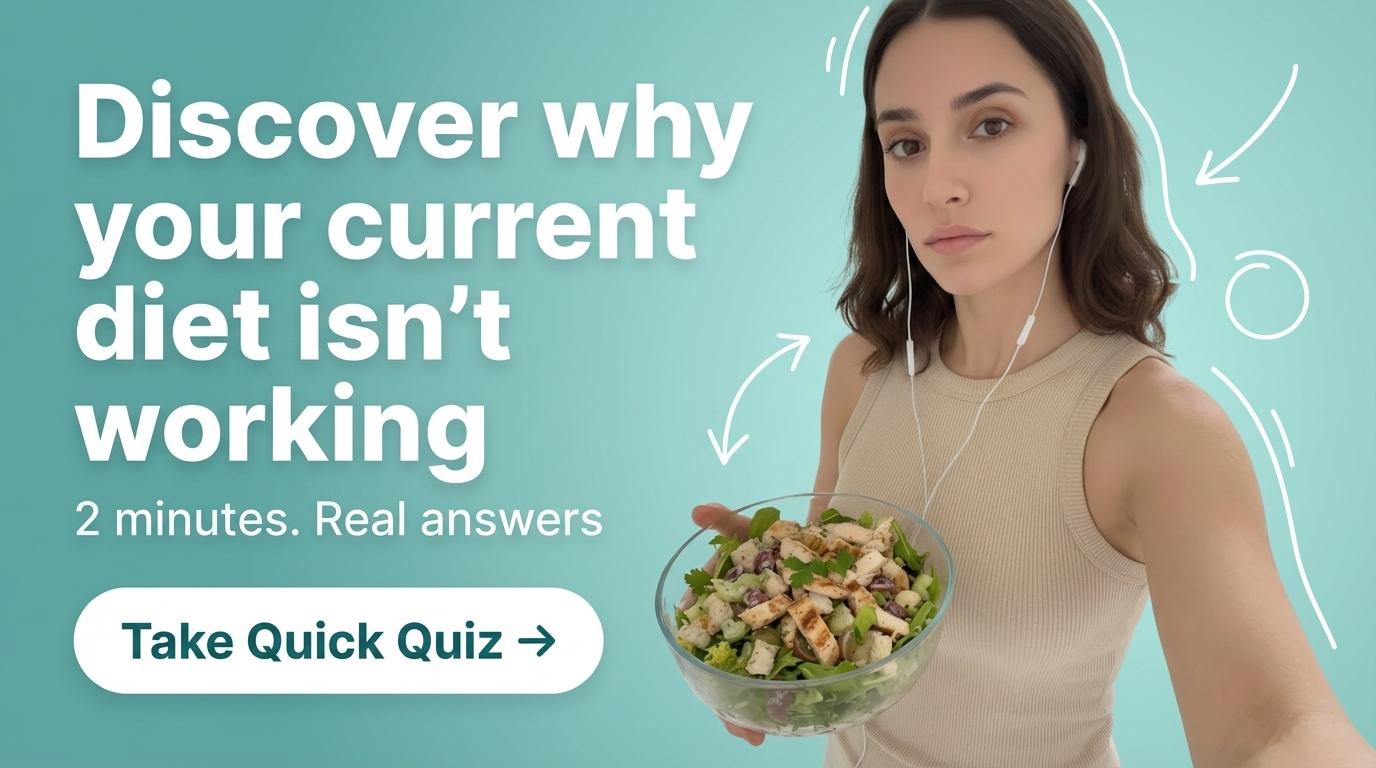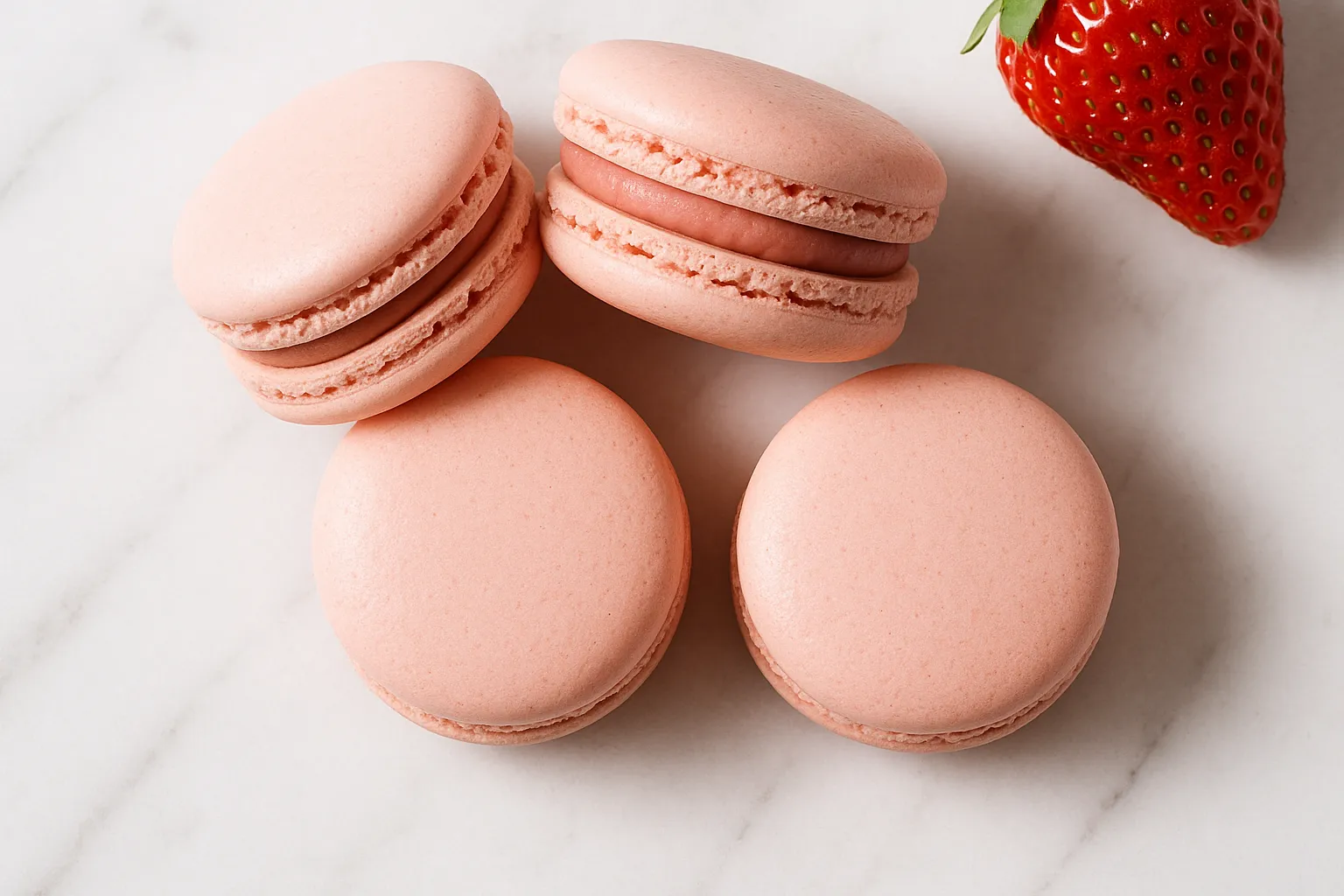Strawberry Macaron: Calories, Nutrition and Health Benefits
A delicate French almond flour confection bursting with strawberry flavor—best enjoyed as an occasional treat within a balanced nutrition plan.
Quick Nutrition Facts
Per 1 Strawberry Macaron (20g)
| Nutrient | Amount |
|---|---|
| Calories | 85 kcal |
| Protein | 1.6g |
| Carbohydrates | 13g |
| Fiber | 0.5g |
| Sugars | 10g |
| Fat | 3.8g |
| Vitamin E | 1.6mg |
| Calcium | 20mg |
| Potassium | 40mg |
| Sodium | 15mg |
Macronutrient Breakdown

NUTRITIONIST INSIGHT
Strawberry macarons shine as an occasional indulgence, not a regular snack. The almond flour base provides some vitamin E and plant-based protein, but refined sugar (10g per macaron) delivers a rapid blood glucose spike. Enjoy 1-2 per week post-meal with tea, not on an empty stomach.
Myth Busters
MYTH #1: Almond Flour Makes Macarons Healthy
TRUTH: While almond flour provides vitamin E (1.6mg) and 1.6g protein, the refined sugar content (10g per macaron) far outweighs these benefits. Refined sugars cause rapid blood glucose spikes and inflammation, offsetting almond flour's antioxidants. View macarons as dessert, not health food.
MYTH #2: Macarons Are Good for Diabetics
TRUTH: Not recommended. Macarons have high GI (70+) due to refined sugar and meringue structure lacking fiber or protein buffering. Blood glucose can spike 45+ mg/dL in 30 minutes. Diabetics should choose dark chocolate, berries, or protein-based desserts instead.
MYTH #3: Strawberry Filling Adds Significant Nutrition
TRUTH: The strawberry filling is often sugar-sweetened jam (60-80% sugar), contributing minimal fiber or vitamin C. Fresh strawberries have 7g fiber per 100g; jam has less than 1g. Homemade macarons with fresh strawberry ganache offer slightly better nutrition but still remain a high-sugar treat.
MYTH #4: One Macaron Won't Hurt Your Diet
TRUTH: True in isolation (85 calories), but context matters. Each macaron contains 10g sugar—nearly half the daily limit for women (25g). Frequent small sugar doses throughout the day trigger insulin resistance and cravings. Limit to 1-2 per week as conscious indulgence.
MYTH #5: Macarons Are Lower Calorie Than Cake
TRUTH: Per ounce, macarons are MORE calorie-dense. One macaron (20g) has 85 calories (425 cal/100g); one slice cake (50g) has 200 calories (400 cal/100g). The difference: macarons are consumed in small quantities naturally (1-2 pieces), whereas cake is served in larger portions, leading to higher total calorie intake.
NutriScore by Health Goals
| Health Goal | NutriScore | Why This Score? |
|---|---|---|
| Weight Loss |  | 85 calories concentrated in 20g, 10g sugar triggers cravings. Avoid; choose berries or dark chocolate (higher fiber, lower impact). |
| Muscle Gain |  | 1.6g protein is minimal; 13g carbs better from oats, rice, or fruit. Occasional post-workout treat only (carbs quickly absorbed but lack glycogen benefit). |
| Diabetes Management |  | High GI (70+), refined sugar (10g) causes rapid spike. Not recommended for diabetics. |
| PCOS Management |  | Refined sugar worsens insulin resistance central to PCOS. Skip in favor of protein/fat-based treats; choose dark chocolate or nuts. |
| Pregnancy Nutrition |  | Not harmful in moderation (occasional treat), but provides no folate, iron, or other pregnancy nutrients. Save calories for nutrient-dense foods. |
| Viral/Flu Recovery |  | Sugar during illness weakens immune response; fast carbs don't sustain energy. Better: honey with lemon, smoothies, or broth. |
PERSONALIZED NUTRITION
Track your meals with NutriScan for personalized NutriScores based on your specific health goals!
Blood Sugar Response to Strawberry Macaron
Macarons cause one of the sharpest blood glucose spikes among sweet foods due to refined sugar and lack of fiber/protein buffering.
Typical Glucose Response Curve
*This chart shows typical blood glucose response for general healthy individuals with refined sugar desserts. Individual responses vary. Diabetics may experience even higher peaks. Not medical advice.*
How to Minimize Impact (If Consumed)
If you choose to eat a macaron, pairing with protein, fat, or fiber significantly blunts the glucose spike:
- ☕ Warm green or black tea - Polyphenols slow glucose absorption by 20-30%; pair immediately before eating
- 🥜 Handful of nuts or seeds - Adds fat and fiber to slow carb digestion; eat simultaneously or within 5 minutes
- 🥛 Full-fat yogurt - Protein and fat buffer sugar absorption; eat before macaron
- 🏃 Post-workout timing - Glucose spikes are partially diverted to muscle glycogen replenishment (least harmful timing)
Best practice: Eat 1 macaron as post-lunch or post-dinner treat after protein and vegetables, with tea. Never on empty stomach.
Cultural Significance
Macarons originated in Italy and rose to fame in France as the elegant confection of choice.
In France:
- Iconic French pastry, perfected in Paris in the 1930s-1960s
- French tradition: pastel colors, delicate shells, flavor pairings (rose, pistachio, strawberry)
- Status symbol: high-end patisseries charge €2-4 per macaron
- Cultural exports: Ladurée, Pierre Hermé define luxury baking standards
Global Adoption:
- Massive popularity in 2010s Instagram era (colorful, photogenic)
- Japanese, American, Indian adaptations with local flavors
- Homemade macaron baking has become a hobby challenge (technical difficulty: 7/10)
- Sustainability concerns: almond farming, packaging waste
Nutritionally:
Unlike traditional French butter-based pastries, macarons rely on air whipping and refined sugar—minimal nutrition by design, maximum indulgence by intent.
Compare & Substitute
Macaron vs Similar Desserts (Per serving)
| Nutrient | 🎀 Strawberry Macaron (20g) | 🍫 Dark Chocolate 70% (25g) | 🍓 Fresh Strawberries (100g) | 🍰 Vanilla Cake (50g) |
|---|---|---|---|---|
| Calories | 85 | 140 | 32 | 200 |
| Carbs | 13g | 12g | 7g | 25g |
| Fiber | 0.5g | 2g | 2g | 0.5g |
| Protein | 1.6g | 2g | 0.8g | 3g |
| Fat | 3.8g | 12g | 0.3g | 10g |
| Sugar | 10g | 8g | 7g | 18g |
| Antioxidants | Minimal (jam) | High (cocoa) | High (vitamin C, polyphenols) | Minimal |
| Best For | Special occasion, 1-2x/week | Regular treat, 1x daily | Anytime, multiple servings | Occasional indulgence only |
Frequently Asked Questions
Are strawberry macarons healthy?
Not particularly. They're best viewed as an occasional indulgence, not a health food. Each macaron contains 85 calories with 10g refined sugar, near the recommended daily limit (25g for women). The almond flour provides some vitamin E (1.6mg) and 1.6g protein, but refined sugar dominates.
Honest take: Enjoy 1-2 per week as a conscious treat post-meal, not daily.
Can people with diabetes eat macarons?
Not recommended. Macarons have high glycemic index (70+) with minimal fiber or protein to buffer blood glucose spikes. One macaron can raise blood sugar 40-50 mg/dL within 30 minutes.
Better alternatives: Dark chocolate (70%+), berries with nuts, or protein-based desserts that balance carbs with fiber and fat.
Do macarons have any nutritional value?
Limited. Per macaron: Vitamin E: 1.6mg (12% DV, from almond flour); Protein: 1.6g (minimal); Fiber: 0.5g (minimal); Antioxidants: Trace (strawberry jam usually processed).
The refined sugar (10g) and calories (85) aren't offset by nutrient density. Choose them for pleasure, not nutrition.
How many macarons can I eat per day?
Realistically, limit to 1-2 per week as a treat, not daily. Here's why: 1 macaron contains 10g sugar (40% of women's daily added-sugar limit per AHA guidelines); multiple daily confections lead to insulin resistance, energy crashes, dental problems. Better to save your indulgence quota for one macaron than nibble all day.
What's the best time to eat a macaron?
Optimal timing: Post-meal (lunch or dinner) after you've eaten protein and vegetables. The existing food in your stomach slows macaron digestion, reducing blood glucose spike.
Avoid: Empty stomach, before bed (energy crash), or mid-afternoon (triggers afternoon slump).
Pairing: Always with warm tea (green or black—polyphenols slow absorption) or after nuts/yogurt.
Are homemade or store-bought macarons healthier?
Negligible difference nutritionally. Homemade macarons let you control ingredients: less additives, possible use of natural fruit vs. jam. Store-bought may include gums, stabilizers, preservatives. However, both are indulgences with 10g+ sugar; nutrition difference is minimal (less than 5%).
Verdict: Choose based on pleasure and accessibility, not health claims.


 ChatGPT
ChatGPT  Claude
Claude  AI Mode
AI Mode  Perplexity
Perplexity 



